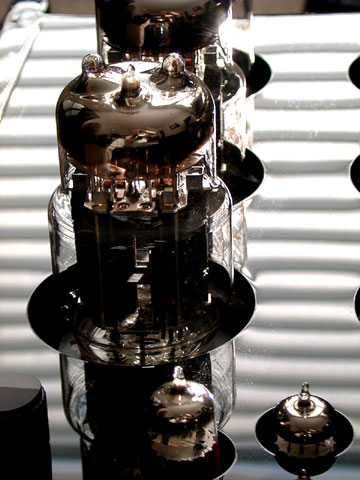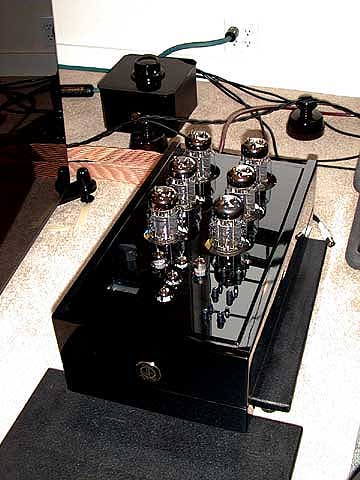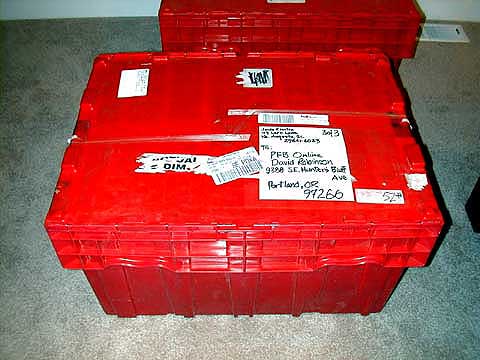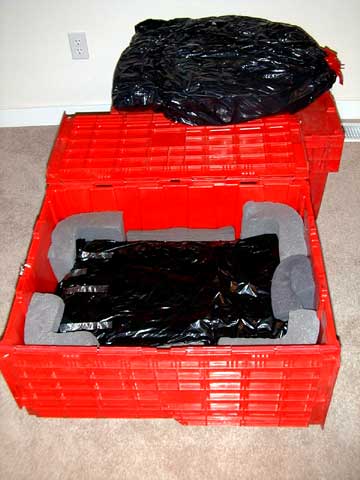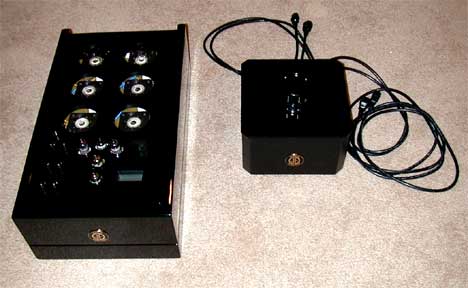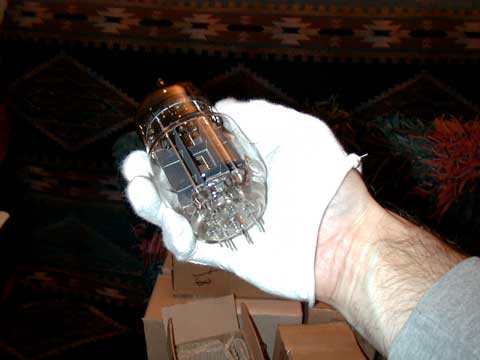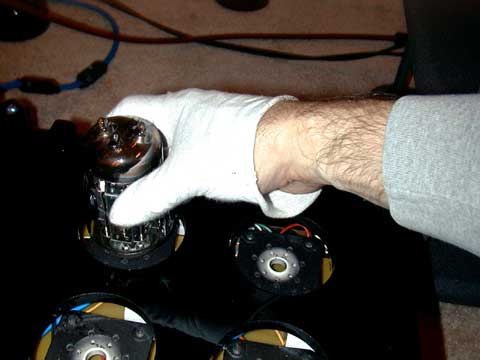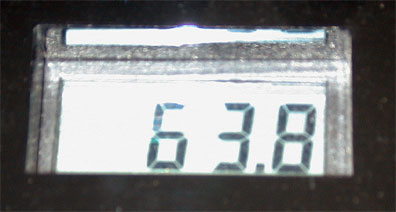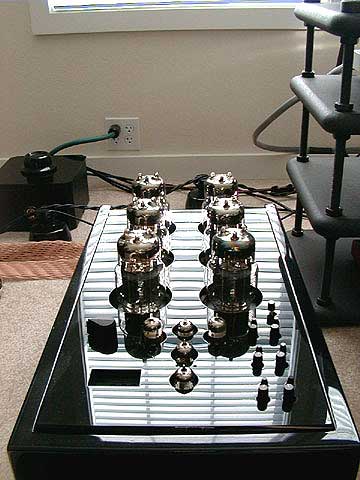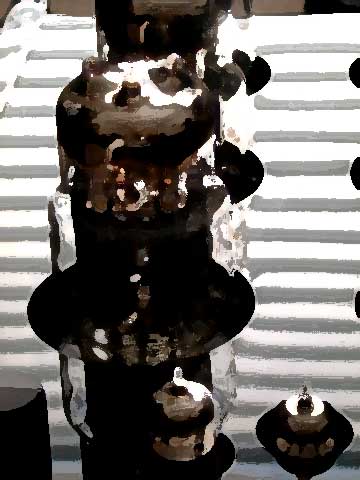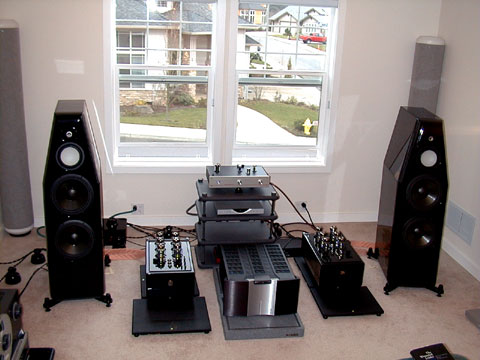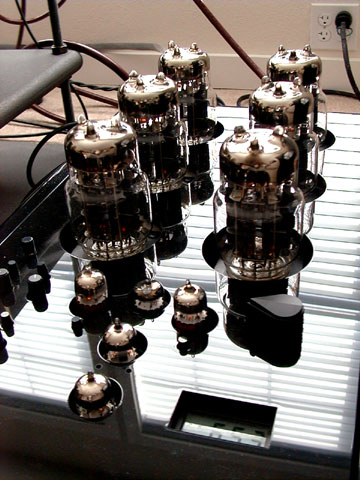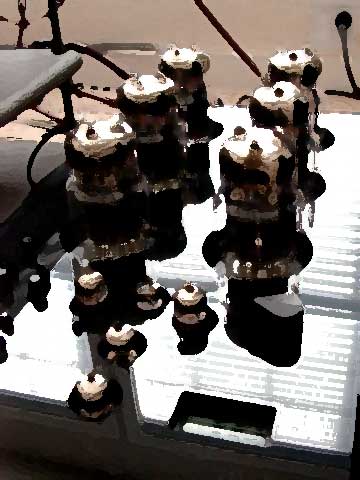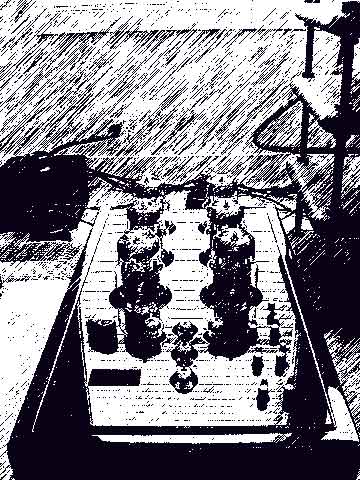|
You are reading the older HTML site
Positive Feedback ISSUE 6
joule electra The Glory of Tubes Rightly Done: Joule Electra's VZN-100 Mk. III Marquis Monoblock Amplifiers by David W. Robinson
(All photos and digital processing by Robinson, unless otherwise noted)
|
||
|
|
A Wealth of Tube Topologies I have a confession to make: during the past year or so I have been indulging myself shamelessly—shamelessly!—in some exceptional tube gear, though I've performed at least partial penance by sharing what I've experienced with you in these pages. Last issue, it was the always rockin', quick and ready Manley Labs Shrimp/Snapper preamp/mono combination (see issue 5 at https://positive-feedback.com/Issue5/manley.htm). Before that, I spent quite a while with the very fine Audio Research Reference Two, Mk. II preamp (issue 3 of PFO at https://positive-feedback.com/Issue3/reference2.htm). Issue 2 saw my delight with the surprising delights of the deHavilland Aries 845 monoblock amps (the 845G version of which is in the queue for a review in the near future, coupled with the deHavilland UltraVerve reference preamp), pair with the Buggtussel Amygdala loudspeaker. (Refer to https://positive-feedback.com/Issue2/dehavilland.htm.) Over the next two issues of Positive Feedback Online, I'll be writing about several other exceptional pieces of fine tube electronics: the Balanced Audio Technology VK-51SE reference preamp, the Manley Labs Steelhead reference phono preamp, the extraordinary WAVAC HE-833 SET monoblocks, and the always clean and musical deHavilland UltraVerve preamp. All of these have given me an opportunity to further educate my sensibilities about the state of the audio arts, and what varieties of fine tube amp designs can do for our much-loved recordings. The current sequence of amplifiers that I've been working with since early last fall has been a unique experience: a chance to compare innovative amplifiers of similar power ratings but radically different topologies in a reasonably consistent environment. I've left the speaker cables and speakers constant (JENA Labs Symphony and Kharma Grande Ceramiques), have likewise kept power cables and line conditioning at stasis (power cables by Cardas, Kimber, and JENA Labs, line conditioning by JENA Labs and Tice), and have been relatively constant with the interconnects (Cardas, Kimber and JENA Labs, varying only as required by distance). The sources have included: my mind-bogglin' stratospheric new SACD reference, the Meitner-modified Philips SACD 1000 and Meitner DAC6; both the Accuphase DP-100/DC-101 reference SACD transport/processor and my highly Richard Kern modified Sony SCD-1 stereo SACD player; my ever-trusty Linn LP-12 turntable system (LP-12/Ekos/the new Akiva reference cartridge/new Linn reference silver turntable interconnect/the new Lingo power supply/Cirkus... and all with a drive cable/springs/oil tune-up by the good folks at Audio Gallery) feeding both the Linn Linto phono pre and the Manley Labs Steelhead phono pre; and my long-term CD playback reference, the classic Linn CD-12. These sources have been used to address three different monoblock tubed amplifiers, each representing a different approach to fine tube design:
To say that it has been uniquely instructive to hear the results of the various approaches in a well known listening environment would be a significant understatement. My experiences underline a point that I've made from time to time in my recent reviews of fine tubed equipment: there is no stereotypical "tube" sound. Reference tubed preamps and amps are fully capable of full-range audio reproduction without compromise, and can no longer be conveniently pigeon-holed as "tubey sounding." The Joule Electra Marquis Mk. III: Overview Jud Barber of Joule Electra is one of the true gentlemen of fine audio; always pleasant and mellow, talking with Jud is a treat. I contacted him last fall, following up on a project to review Joule Electra's products. (This is something that I've wanted to do for 2-3 years now, but logistics and some problems with family issues had kept us from being able to make a connection.) To my delight, this time around way was clear for us to make arrangements, and Jud agreed to send along a pair of his 100 WPC Marquis Mk. III monoblocks. There were no further delays, either; by middle fall, the amps arrived, as promised—though Jud told me up front that the amps would have to be shipped to Las Vegas in time for CES 2003. No problem... I could be done by then. The Joule Electra VZN-100 Mk. III Marquis are a 100 Watts per amplifier, Class A OTL design. The tube population is a complex mix; each monoblock sports the following: six big 6C33-CB output tubes; two 6DJ8's; two 6350 dual triodes on the driver section; and one 12AX7 dual triode. A separate variac handles powering up and supplying both monoblocks.
The Joule Electra VZN-100 Mk. III Marquis on a Townshend Seismic Sink; in the background is the variac used to power both monoblocks, plugged with the new Kimber PK-10 Palladian reference power cable. Joule Electra rates the power output of the VZN-100's at 100 Watts into 8 ohms, and 80 Watts into 4 ohms. My experience with these amps over time showed that it was very stable into 3-4 ohms; I don't think that I would match it any speakers with lower impedance than that, though. (If you're down into the 2 ohm range, you may want to get a different pair of speakers anyway!) Power consumption is about 400 Watts, pretty typical for Class A operation at this power rating. Given the fact that there are no transformers, the weight is surprisingly light at about 40 pounds per side. (The variac is very heavy, though!) There is a pile of point-to-point wiring inside... as it should be! The dimensions of the amp are 12" wide x 18" deep x 9" high, making it reasonably compact. The body of the Marquis is made of wood, finished in a very attractive gloss black... think "Steinway." It matched the finish of the Kharma Grande Ceramique loudspeakers quite well, and made for a visual treat while listening. Joule Electra has other finishes available, but for me, I'd take the black...
Setup The VZN-100's arrived well packaged in some unusually sturdy shipping containers. I don't know if Joule Electra does this with all of their gear; since these are the "official show/review amps," the packaging may well have needed to resist constant re-shipping. But I've never seen anyone else use high-impact plastic shipping containers this way—it's a great idea!
The pair of VZN-100s in their shipping containers...
...and the interior view. A very intelligent way to ship amplifiers.
The variac (black bag) and tubes were shipped in a separate plastic container. All were sealed down with nylon zip ties, and reinforced with strapping tape... sturdy stuff. Very smart, Jud! The installation notes that accompanied the containers were thorough, and made the step by step unpacking and installation pretty easy. I carefully removed the variac and tubes from their container, then the amps. Once the protective materials were removed, the amps dusted, and the sockets carefully inspected for loose packing chunklets, I was ready for the next step.
A VZN-100 awaiting its 6C33-CBs (left); the Joule Electra power supply and variac (right). Note the double power leads on the variac. The amps came with the front-end tubes in place; all that I had to do was insert the 6C33-CBs in the back end. Placing six per side isn't too hard, provided that you don't hurry the task.
Six of these big triode tubes... yowzah!
Socketing the first of the big triodes—always remember your tube glove, chilluns! Once all the tubes were socketed and checked for firm seating, I plugged the unique double IEC power cables from the Joule Electra variac power supply (no favorite specialty cables allowed here!), then plugged a Kimber PK-10 Palladian reference power cable into the main power supply. Connection to the rest of the system was via a pair of JENA Labs unbalanced interconnects—there is no provision for balanced operation. Then I was ready to fire it up... which is something you never want to see literally in tube amplification! Powering up the Joule Electra amps is different than most other amps that I've worked with. Unlike simple on/off switching, or power on cycles with "soft start"—where the output stage is not fired up until the amp has had a few seconds to come online—the VZN-100s are brought on by manually turning up the variac slowly, steadily, over a period of some 10-15 seconds. You do so until you get the voltage readout on the handy-dandy digital display.
According to the documentation, you adjust the variac until the amps stabilize at as close to 65 as possible. There were minor variations between the two amplifiers, but generally I was able to keep things in the 64.8-65.8 range. In my experience, this put the dial at about the 10:00 position. Knowing that, I would turn the dial for 10-15 seconds until I reached that point, then use the voltage readout to pinpoint the precise placement for the beginning of a listening session. As the tubes heated up, I would go back in 30-60 minutes and fine-tune the voltage... no problem at all. Very quick and easy, once you got the hang of it. And I never had any difficulties with the VZN-100s; they always came up immediately, without any pain, and were as reliable as I could wish. Biasing was the next step. You don't do this right out of the box; it's wise to let the tubes cook for a few hours and stabilize. Biasing tubes is a procedure that's easy, once you learn how to do it, but the method can vary from manufacturer to manufacturer. Some tell you to get a meter and do it the old-fashioned way; others have gone to the point of auto-biasing their systems. And if you have a LOT of tubes on the amp, even simple procedures can be time-consuming. Twelve tubes isn't the end of the world, but it would be a hassle if you had to haul out a multi-meter. Joule Electra takes most of the suffering out of biasing by providing an on-board biasing system that uses a series of clever dedicated circuits built right into the amplifiers, one per tube.
In the photograph above you can see the digital display as the darkened rectangle on the lower left; the biasing selectors and adjustors are the small knobs on the lower right, in two vertical rows. The upper button of each set selects the tube and takes over the digital display, which then gives you a bias reading for that tube instead of the voltage reading for amp. To check the bias of each tube, you just select, press and hold down the button for the tube, read the output, adjust as needed—then on to the next tube. Once you get the body English down, it's a very simple and elegant system... I confess that like it very much. Also in the photo above, you can see an oblong knob above the digital readout and to the left of the input section. This controls the amount of feedback that the amplifier uses. The 9:00 position pictured is the default of "zero feedback," which was recommended. That's where I left it, but others might want to experiment with the feedback setting in their listening rooms—that's what it's there for! Notes on the sound
Somehow or the other, Jud, a true wizard of OTL, has managed to consistently produce great OTL designs over the years, getting very fine results from the devilishly difficult OTL topology. My good friend Gizmo used to talk to me about how hard it was to get OTL right—but that when they were right, how awesome the sound could be. (Think OTLs aren't so rare? Try counting the number of manufacturers currently producing them. Hint: you won't need too many fingers.) I knew that the Joule Electras had magic. I had heard these amps at CES 2001, where they shared the room with Bobby Palkovic's dy-no-mighty Merlin Millennium speakers. Yes, I know, and have said this many times before: shows are really a poor place to audition the real performance of a fine audio design. Regardless, I was struck by what a terrifically musical system the Joule Electra/Merlin combo was (an impression that was reinforced at CES 2003; see my CES show reports in Issue 5 of Positive Feedback Online). And now, at last, I had them.
The Joule Electra VZN-100s flanking the BAT 6200 six channel amplifier (center) and connected to the Kharma Grande Ceramique speakers. In this configuration, the JE gear was connected to the deHavilland UltraVerve preamp and Linn Kontrol preamp (all too briefly!), and cabled via Kimber Select interconnects. I gave the VZN-100s a week to fully get up to speed, powering them up and listening to them for hours at a stretch. New or old, this is standard procedure for me; I want to be sure that I have a few dozen hours on an amp before I even begin to listen to it. But I have to admit that the VZN-100s pulled me in before my usual limit. From the very beginning, the quality of the music they made was very alluring. Right out of the box, they were very quiet. A very slight hum, not noticeable when listening (I've heard much worse... the Graaf 200 WPC OTL had more of a hum than this); a touch of faint white noise when powered up. Nothing else. Connected to the exceptional Kharma Grande Ceramiques—a reference level speaker if ever there was one—the VZN-100s had a sound that wasn't like other tube amps that I had had in my listening room. I noticed immediately that SACD and LP sources had a really appealing combination of quickness, rhythm, and clarity. There being no "big iron" in the amp, there was nothing to slow down transients, nothing to stand in the way of the music that was flowing through those glorious 6C33-CB tubes, well known for their linearity and power. It showed, too: at the lower frequencies, the VZN-100s delivered bass that was rich and rounded. My Japanese SACDs of the Kodo drummers (warabe or tsutsumi) delivered marvelous, gut-level, well rounded sound. Naturally, Spitball's Pop Condition SACD, that rare disc with truly subsonic and dynamic pure DSD bass came out; the VZN-100s handled all but the very lowest passages (on cuts 1, 2 and 8, for those of you fortunate enough to have a copy). Even then, the amp didn't clip horribly. Heck, even the Linn Klimax amps driving the Linn Komri's with their 2kW bass servo section have to move hard to stay up with this passage, which says a lot for the staying power of the Joule Electra. Another great disc for bass is the CCnC release, Shifting Landscapes, with compositions from Adams and Sumera. Listening to SACDs like these on the VZN-100s was a treat: deep, round bass, but no tubbiness.
The midrange was, as might be expected, excellent. Favorite SACDs like the Vanguard Songs of the Auvergne, FIM's Audiophile Reference IV and River of Sorrow, and anything from Rounder Records on SA... well, it was just wonderful. Nick Drake on Simply Vinyl LP via the LP-12 system was so haunting, it was scary; the ache and yearning in his voice and guitar were so right. I've had other 6C33-CB amplifiers in my system, but none that I enjoyed like this one. There's a rightness to the vital midrange tonality that avoided all the hackneyed stereotypes about "golden tube sound." (If you don't have the mids right, then Netanya Davrath, Bruce Cockburn, Alison Krause, James Taylor, and [even] Mick Jagger don't sound right, SACD or no SACD.) There are certainly amps that sound that way: this isn't one of them. Even the high frequencies, though, were very fine. No ringing; no tizziness; no roll-off; no overhang. The clarity of OTLs was evident... which is very important with SACDs. Running full out on the frequency response, preamps and amps are being hit with a much higher bandwidth (and more ultrasonic noise, a very acceptable concomitant element of DSD... given how wonderful the results are!) than ever before. The VZN's produced clear and extended high frequencies to the Kharma Grande Ceramiques, remained as stable as a rock, and never gave me the feeling that the upper reaches were becoming glassy or etched. The especially pleasant thing about the VZN-100s was that all frequency ranges were well integrated, preserving the sense of musical wholeness. The Kharma Grande Ceramiques are a very special speaker, very coherent—and very revealing—and the Joule Electras were shown to be a very synergistic match. (Kharma lovers, take note!) In the realm of imaging and soundstaging, the VZN-100s passed with flying colors. They presented a soundstage that was every bit as good as any amplifier, solid state or tubed, that I've had in my room. They were wide, high, and very deep... this last is most important with SACDs and LPs, as soundstage depth is one of the most important things delivered by those superior formats. (CDs need not apply particularly in this area; they simply cannot deliver depth. Among some other things.) Listen to "A Dream Like Mine" on Bruce Cockburn's anything anytime anywhere: singles 1979-2002 on Rounder Records SACD... or the Stones doing "Lady Jane" on SA... or Natania's lilting voice... or the BMG SACD of Stokowski's RCA Living Stereo Rhapsodies... and feel the far end of your listening room simply melt away. With the Joule Electras, magic happens this way.
Dynamics were no problem. Apart from some of my worst acid tests (particularly a few places in Pop Condition mentioned previously), macrodynamics... think "dynamic range"... were very fine, due to the real quickness and responsiveness of this amp. Microdynamics... think "inner detail," pizzicati, or whatever metaphor lights your lamp... were well revealed, again due, I think, to the fine clarity of this amplifier. The combination of all the above also means that the Joule Electra VZN-100s have great rhythm and real musicality. This is where the quickness and transparency of this amplifier really comes through. There is no unpleasant trade-off between music, timbre, pace or resolution; this amplifier provides a way to unify these properties, and eliminates the need for painful soul-searching for those who love tubes, but don't need romanticism. The result for me was clear: toes a-tapping, head a-nodding, and smiles whenever I listened. Others here at the magazine agreed. My good friend, President of JENA Labs, and fellow PFO'er, Jennifer Crock, long a fan of good OTL work, was extremely impressed with Jud Barber's work when she dropped by one afternoon to have a listen. "Gee," sez Jen, "this looks great and sounds really good!" Dem's high praise, coming from the Jennifermeister; she's pretty hard to please, and has heard a lot of OTL designs. Several other members of the PFO editorial group were also very favorably impressed by the sound of the Joule Electra/Kharma Grande Ceramique tandem; one writer even went so far last November as to say "this is the best that I've heard your system sound." A quick aside on reliability One of the classic questions about OTLs has been their alleged poor reliability. Without descending into the long-standing debates/arguments that have been hashed over for years, and in which I have absolutely no interest, I should simply note that I did not have a single problem with the Joule Electras in the several months that they were in our listening room here at PFO Central. Not one. Zero. Nada. The VZN-100s always came up, were always working.
Conclusion The VZN-100 monoblock OTLs provided such an array of musical and audio virtues that it was a very sad moment when I had to ship them to Las Vegas in time for CES 2003. So how good is this amplifier? Well, I would have to say that the Joule Electra VZN-100s are certainly the best OTL amps that I've ever heard, and one of the finest tube amps of any kind that I've had in my listening room... which goes back over 13 years of listening and reviewing now. They provided rich delight, were absolutely reliable, and made world-class music with any genre that I tossed at it via SACD or turntable. At about $15,000 per pair (the VZN-100 in standard leatherette covered case is $13,000 and the music wood version, which is the subject of the review, is an additional $2000), the VZN-100s aren't inexpensive, but neither are they anything like the most expensive amps you can buy in the world of fine audio. If you are looking for 100 WPC of reliable, exceptional tubed power that won't force you to choose what musical values you must leave behind, then I strongly urge you to consider the Joule Electras. In a word, their performance is simply magnificent. Therefore, I award the Joule Electra VZN-100 OTL monoblocks a "Ye Olde Editor's Highest Recommendation." Enthusiastically. For more information: Joule Electra |

